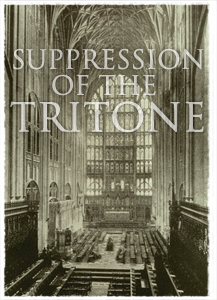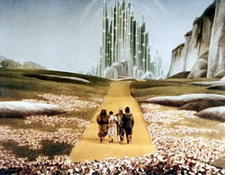Anti-Harmonic Agenda of the Medieval Church
By Richard Merrick
So having sifted through a bit of medieval history, are we any closer to explaining the tritone?
 Well, we do have a better historical context within which to understand the tritone. We know that the rise of the Inquisition with its canon laws were driven by the Church’s project to eradicate paganism and with it the free study and use of harmony. We know that at the center of this anti-pagan campaign was the musical tritone – Diabolus in Musica – the harmonic interval most likely to reveal knowledge of the golden ratio. And we know that fear of this musical interval and what it represented is what shaped music history.
Well, we do have a better historical context within which to understand the tritone. We know that the rise of the Inquisition with its canon laws were driven by the Church’s project to eradicate paganism and with it the free study and use of harmony. We know that at the center of this anti-pagan campaign was the musical tritone – Diabolus in Musica – the harmonic interval most likely to reveal knowledge of the golden ratio. And we know that fear of this musical interval and what it represented is what shaped music history.
Under the Church’s anti-harmonic agenda, suppression of the tritone in music was crucial. Canon laws were passed to mandate rules for how to construct scales, how to handle voice leading, what was considered consonant and dissonant, how contrary motion should be handled, what tones should and should not be emphasized in rhythm, which rhythmic patterns were acceptable and specific instructions for how music should be written. Tritone omission was the first principle – the foil, if you will – behind all of these rules.
But the tritone was much more than this. It was the model for all canon law and became the legislative model used to prosecute paganism in general. It was the ethical justification behind the Inquisition in its mission to eradicate Pythagoreanism, Platoism, Mithraism, Egyptian Hermeticism, Zoroastrianism, the Hebrew Kabbalah and similar Gnostic teachings in revival during the 11th through 13th centuries. With tritone omission at the front line of its plan to control Europe, the Church mounted a Great Crusade against the very cradle of civilization – the people who had discovered and preserved the ancient knowledge of harmonics. The Church knew that eradicating paganism simply could not be done without first eradicating free harmony in music.
Along with the tritone, the harmonic geometries of the pentagram and hexagram were cast as evil pagan symbols and linked with satanic worship, witchcraft and occult ritual. Those who studied such harmonic properties in numbers, geometry and astronomy, like the Cathars of southern France, were threatened, executed or exiled, forcing many to roam the countryside as ‘gypsies’ (a pejorative form of Egyptian). The Knights Templar, the primary keepers of the Babylonian and Egyptian temple mysteries, were then hunted down and murdered by the Church (on Friday, October 13, 1307) with a few fleeing to far-flung places like northern Scotland. Within a few hundred years, the Church had managed to seek out and crush most competing pagan religions across Europe, leaving only a few small groups that met in secret.
Viewing the medieval Church through the musical lens of a tritone makes it easy to see how broad and comprehensive their anti-harmonic strategy really was. Even the Biblical story of the Garden of Eden was a manifesto against Pythagorean and Egyptian beliefs. The serpent in the Tree of Knowledge (representing spiraling Fibonacci growth) whose fruit was the Apple of Knowledge (with its circular pentagram and golden ratio at core) was presented as the foremost agent of evil in the world. As the first principle on the first page of the Bible’s lead story, Genesis was a dire warning to all who might seek to follow the Greek and Egyptian path into the Underworld to discover nature’s harmony for themselves.
For if a perfect order were thought to exist in nature, immediate and present in everything, there would be no need for a separate creator, no need for an intermediary savior and no need for the Church to intercede on behalf of God. People would simply seek answers directly from the world around them and in their own ‘inmost chamber’ as had always been the shamanic way of tribal cultures. The Church fathers had little choice but to demonize and outlaw all musical-astrological symbolisms, whether auditory or visual, to establish and maintain social control.
Along with the tritone, the harmonic geometries of the pentagram and hexagram were cast as evil pagan symbols and linked with satanic worship, witchcraft and occult ritual.
In the final analysis, the suppression of harmonic knowledge was an unparalleled success. Today, the tritone is still avoided in music theory textbooks and classrooms. At the same time, the golden ratio buried inside harmonic oscillation is mostly avoided in scientific research. Its true role in physics, physiology and human perception remains underappreciated and downplayed. Indeed, all harmonic philosophies have been discredited in Western society to such an extent that their very absence has served to propagate the same anti-harmonic doctrines instituted long ago by the medieval Church. In this sense, the Inquisition and Crusades never ended.
The monumental struggle between the Church and paganism has been told many times, in many ways. But of all the stories, none has resonated with people more than the 1939 film The Wizard of Oz starring Judy Garland. Based on the book The Wonderful Wizard of Oz by L. Frank Baum, this film is usually thought of as a nice American fairy tale or perhaps a thinly veiled political commentary, as suggested by Henry M. Littlefield in his ‘Parable on Populism’. But it is more likely a tale of the Roman Catholic Church’s war against paganism and the freedom to pursue truth in nature.
 It all begins on the Kansas prairie, a symbol for the colorless material world, with a girl named Dorothy Gale (1). After singing Somewhere Over the Rainbow, in which she wishes upon a star, our heroine is swept up by a spiraling tornado and deposited in a colorful and musical place called Munchkinland (2). Populated by a cherub-like pagan tribe called Munchkins , their leader the good witch Glenda presents magical ruby-crystal slippers to Dorothy. She is then told to follow the yellow brick road (a continued golden spiral from the twister) to reach the great wizard of Oz who has the power to send her home. Taken from the Hebrew name meaning ‘strength,’ Oz represents enlightenment in the ‘inmost chamber’ of Dorothy’s mind.
It all begins on the Kansas prairie, a symbol for the colorless material world, with a girl named Dorothy Gale (1). After singing Somewhere Over the Rainbow, in which she wishes upon a star, our heroine is swept up by a spiraling tornado and deposited in a colorful and musical place called Munchkinland (2). Populated by a cherub-like pagan tribe called Munchkins , their leader the good witch Glenda presents magical ruby-crystal slippers to Dorothy. She is then told to follow the yellow brick road (a continued golden spiral from the twister) to reach the great wizard of Oz who has the power to send her home. Taken from the Hebrew name meaning ‘strength,’ Oz represents enlightenment in the ‘inmost chamber’ of Dorothy’s mind.
(1) The name ‘Dorothy’ is of Greek origin and means ‘gift of God.’ When taken together with the tornado, the name Dorothy Gale implies that the spiraling whirlwind that Dorothy travels through is a gift of God.
(2) ‘Munchkin’ is probably a contraction of the German words ‘Munchen’ and ‘kinder,’ meaning ‘Munich children.’ In the original story, the Munchkin were described as all wearing blue clothes corresponding to the blue in the Bavarian flag and the Blue Lodges of German Freemasonry.
As she walks in fear along the golden path, traveling through a dark forest symbolizing nature, she meets three wise men – the Scarecrow, the Tin Woodsman and the Cowardly Lion. As personifications of Dorothy’s fear, the mindless Scarecrow represents her loss of reason and direction, the rusty Tin Woodsman her loss of heart and spirit, and the Cowardly Lion (the Egyptian sphinx) represents her loss of courage and confidence. At the end of her journey, just before she is about to fall asleep under an evil spell, Dorothy arrives at the legendary Emerald City of Oz – symbolic of the Emerald Tablet of Egyptian philosopher Hermes Trismegistus.
 Gaining entry to the city, Dorothy asks to see the ‘great and powerful Oz’ to ask for his help in returning home. When she meets the wizard, appearing as a terrifying personification of the medieval Inquisition, he is the gatekeeper to knowledge and demands that she dispose of his adversary, the Wicked Witch of the West, to learn how to return home. As the wizard’s crusader against paganism, Dorothy journeys to the witch’s lair and sneaks into her watchtower, but is discovered and captured. Fortunately, Dorothy manages to escape and ultimately slays the pagan witch through holy baptism.
Gaining entry to the city, Dorothy asks to see the ‘great and powerful Oz’ to ask for his help in returning home. When she meets the wizard, appearing as a terrifying personification of the medieval Inquisition, he is the gatekeeper to knowledge and demands that she dispose of his adversary, the Wicked Witch of the West, to learn how to return home. As the wizard’s crusader against paganism, Dorothy journeys to the witch’s lair and sneaks into her watchtower, but is discovered and captured. Fortunately, Dorothy manages to escape and ultimately slays the pagan witch through holy baptism.
Having conquered paganism, Dorothy returns triumphantly to the wizard and again pleads with him to take her home. But instead of honoring his promise, the fiery wizard orders her away. Angry at the wizard’s broken promise, Dorothy’s dog Toto (representing her inner spirit and intuition) pulls back a velvet curtain (symbolizing the façade of Church doctrine) to reveal the fact that the powerful wizard is no great deity after all – just a man.
Now enlightened and full of inner strength, Dorothy takes back her reason, her intrinsic spirituality and her courage along with a promise from the would-be wizard (whose real name is Oscar Zoroaster (3)) to take her home. But as the former carnival wizard (now representing modern science) is about to spirit her away in a balloon (symbolizing technology), an error occurs and he only saves himself, leaving Dorothy to find her own way home.
While it would seem that Dorothy had lost her last chance to find salvation, the good witch Glenda (meaning ‘holy and good’) suddenly reappears in a sphere to tell her she can return any time she wants through the power of 3 in her own mind. With this, Dorothy realizes that salvation is not found in the promises of either religion or science, but only in the inmost chamber of her own mind. As she wakes up from her inner Underworld adventure, we too wake up to the black and white reality that nature’s harmony has remained hidden from Western society far too long (4).
(3) The wizard’s first name Oscar means ‘spear of the gods.’ His last name then corresponds to the ancient Iranian prophet Zoroaster (meaning ‘living star’), who founded the musical-astrological theosophy known as Zoroastrianism. Under this belief, the universe is seen as a cosmic struggle between truth and lie, giving rise to Free Will. Pythagoras was rumored to have studied with Zoraster in Babylonia.
(4) If there is any doubt that this is the interpretation Baum most likely intended, consider the fact that he also anonymously wrote The Last Egyptian: A Romance of the Nile about an English Egyptologist, an Egyptian woman named Kāra and a Dragoman named Tadros. It seems Kāra was a descendent of Ahtka-Rā, High Priest of Ặmen (Ra), the Egyptian sun god.
We now know with some certainty the cast of characters who worked so hard behind the velvet curtain to conceal the truth about the tritone and its relationship to nature. It started with Boethius, then Alcuin of York, Aurelian of Reome, Guido of Arezzo, Gerbert of Aurillac, Odo of Clunym, Isidore of Seville, Hermannus Contractus, Johannes Cotto, Franco of Cologne, monk Gratian and ultimately Pope Gregory IX. Each of these people, all in good faith of course, played critical roles in establishing the tritone’s unfortunate reputation in music history and scarce mention in music theory.
We also know how and when the tritone was outlawed. Rules of omission began to take shape during the rise of Catharism in the 11th century with Guido of Arezzo. They were then systemized by monk Gratian and further codified in the late 11th and early 12th century by both Johannes Cotto and Franco of Cologne. In 1234, Pope Gregory IX then promulgated this musical doctrine into canon law as a philosophical cornerstone of the Catholic Inquisition, requiring every Roman Catholic Church to honor its policy of tritone avoidance.
Yet even as these tritone omission laws became increasingly entrenched into the late Renaissance, a rebellion was brewing against this and other papal laws. Leading the charge was, of course, German monk and theologian Martin Luther.
Content courtesy of Richard Merrick
Copyright (c) 2011. All Rights Reserved.









